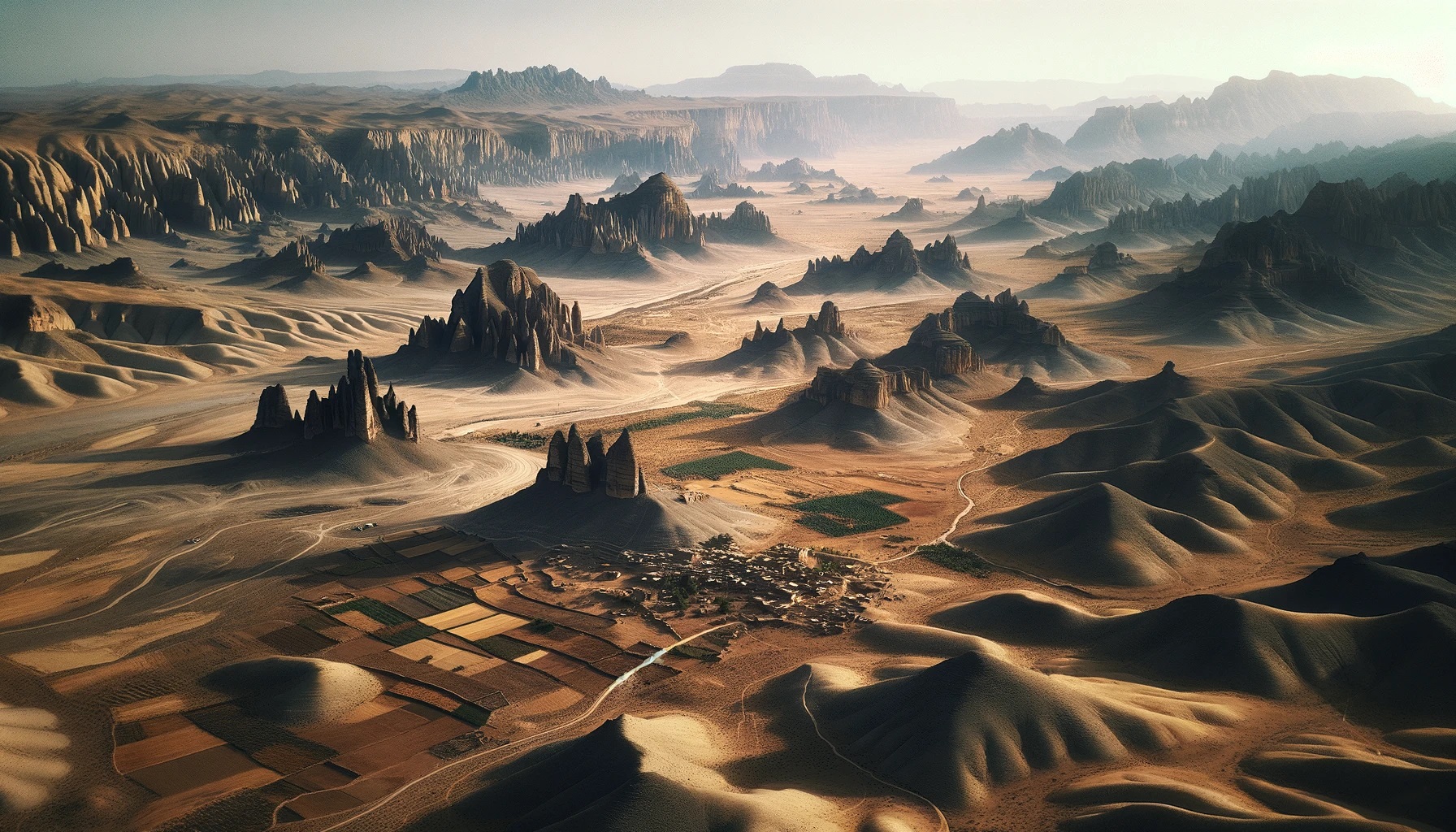Watto/Western Watto
The Estate of Western Watto
Western Watto is a land of rugged beauty and relentless challenge. Its badlands, rolling hills, and encroaching desert create a landscape that is both awe-inspiring and formidable. The region's physical layout is a testament to the power of natural forces and the resilience of those who call it home. Despite the harsh conditions, life persists in Western Watto, a testament to the enduring spirit of its inhabitants and their ability to adapt and thrive in one of Beluaterra's most demanding environments.
The lands of Western Watto
Western Watto, the wilder and more rugged of the two estates within the region of Watto, presents a landscape of stark beauty and harsh contrasts. It stretches towards the encroaching desert to the west, marked by a terrain that is less hospitable yet holds a unique, austere charm. The physical characteristics of Western Watto are shaped by the interplay of natural forces and the enduring struggle of its inhabitants to carve out a living from the unforgiving land.
The heart of Western Watto is dominated by classic badlands terrain. Here, erosion has sculpted the landscape into an intricate maze of buttes, pinnacles, and spires. These towering rock formations rise dramatically from the ground, their rugged surfaces etched with deep crevices and layered with sedimentary rock in varying hues of red, orange, and brown. The buttes, standing tall like ancient sentinels, offer breathtaking views of the surrounding landscape and serve as natural landmarks in this otherwise featureless expanse.
Amidst these rocky outcrops, the ground is often dry and cracked, bearing witness to the relentless sun and the scarcity of water. Sparse vegetation clings to life in the crevices and along the more sheltered slopes. Hardy shrubs, cacti, and drought-resistant grasses are the primary flora, their resilience emblematic of the tenacity required to survive in such an environment. During rare rainfalls, these plants burst into brief but vibrant life, their blooms adding splashes of color to the otherwise muted palette of the badlands.
The rolling hills of Western Watto are a transition zone between the more fertile lands of Eastern Watto and the harsher desert to the west. These hills are characterized by a mix of rocky terrain and patches of poor soil, capable of supporting only the hardiest of crops. Small, terraced fields and isolated farms can be found here, where the inhabitants eke out a living by cultivating drought-resistant grains and hardy vegetables. The fields are often bordered by stone walls, built from the abundant rocks that litter the landscape, providing some protection against the wind and erosion.
Rivers and streams in Western Watto are fewer and more intermittent compared to their counterparts in the east. These waterways are lifelines in this arid region, their banks supporting narrow bands of greenery. Willows, alders, and tamarisk trees grow along these watercourses, creating verdant oases amidst the dry land. These riparian zones are crucial for both human and animal inhabitants, offering water and shelter in an otherwise inhospitable environment. During the dry season, many of these streams reduce to trickles or dry up entirely, emphasizing the region's dependence on the sparse and unpredictable rainfall.
The further west one travels, the more the landscape begins to resemble the desert that lies beyond the borders of Watto. Sandy dunes and dry riverbeds become more common, the soil giving way to loose sand and gravel. This area, while less populated, is not devoid of life. Nomadic tribes and hardy settlers have adapted to the harsh conditions, living in portable shelters and relying on a deep knowledge of the land to find water and sustenance. These inhabitants often herd goats and sheep, animals well-suited to the arid environment.
Scattered throughout Western Watto are the remnants of ancient structures and fortifications, relics of past conflicts and civilizations that once thrived in the region. Crumbling watchtowers and deserted villages tell stories of a time when the land was more contested, serving as stark reminders of the region's turbulent history. These ruins, often perched atop the highest buttes or nestled within hidden valleys, add a sense of mystery and timelessness to the landscape.
The climate in Western Watto is characterized by extremes. Summers are long and scorching, with temperatures soaring during the day and plummeting at night. The relentless sun bakes the land, making midday travel arduous and dangerous. Winters, while milder in temperature, bring cold winds that sweep down from the northern mountains, chilling the air and causing frost to form in the valleys. Rainfall is sparse and erratic, with occasional thunderstorms that bring brief but intense downpours, causing flash floods that carve new paths through the badlands.
Despite the harsh conditions, Western Watto is not devoid of human settlement. Small, fortified towns and villages are scattered throughout the region, often located near water sources or along trade routes. These settlements are characterized by sturdy, practical architecture, built to withstand both the elements and potential attacks. Stone houses with thick walls, narrow streets, and communal wells are common features. The inhabitants of these towns are a hardy and resourceful people, accustomed to the challenges of their environment.
Western Watto's proximity to the desert also makes it a region of strategic importance. It serves as a buffer zone against potential incursions from the west, whether by human foes or the monstrous creatures that roam the desert. Watchtowers and garrisons are strategically placed along the border, manned by vigilant guards who keep a constant lookout for threats.
Lord of the Estate
The current lord of the Western Watto Estate is Aric Highvale (June 2024)
